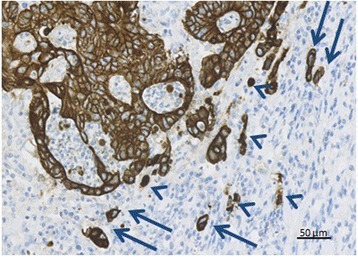Does heterogeneity matter in the estimation of tumour budding and tumour stroma ratio in colon cancer?
- PMID: 29558947
- PMCID: PMC5859415
- DOI: 10.1186/s13000-018-0697-9
Does heterogeneity matter in the estimation of tumour budding and tumour stroma ratio in colon cancer?
Abstract
Background: Tumour budding (TB) and Tumour Stroma Ratio (TSR) may be rewarding in the treatment stratification of patients with stage II colon cancer. However, lack of standardization may exclude these parameters from being used in a clinical setting. The purpose of this methodologic study was to compare stereology with semi-quantitative estimations of TSR, to investigate the intra-tumoural heterogeneity of TB and TSR, and to assess the intra- and inter-observer agreement.
Methods: Three paraffin embedded tumour blocks, one of them representing the deepest invasive front, were selected from each of 43 patients treated for stage II colon cancer. TSR was estimated in H&E sections semi-quantitatively using conventional microscopy, and stereologically on scanned slides, using the newCAST stereology platform. TB was scored across 10 high power fields at the invasive front in cytokeratin AE1/AE3 stained sections.
Results: Subjective, semi-quantitative estimates of TSR significantly correlated to the stereological estimates, with the best correlation found for sections with the deepest invasive tumour penetration (σ = 0.621, p < 0.001). Inter-observer agreement was moderate to substantial for both TB (Κappa = 0.46-0.73) and TSR (Κappa = 0.70-0.75). The Intraclass correlation coefficient (ICC) for TSR varied from 0.322 based on stereological hotspot estimation to 0.648 for the semi-quantitative evaluation. For TB, ICC varied from 0.646 based on continuous data to 0.698 based on categorical data (cut-off: 10 buds). Thus, the intra-tumoural heterogeneity for both TB and the semi-quantitative estimation of TSR was low.
Conclusion: We recommend using only one tissue section representing the deepest invasive tumour area for estimation of TSR. For TB we recommend using one tissue section; however due to low representation of high-budding tumours, results must be considered with caution.
Keywords: Colon cancer; Heterogeneity; Tumour budding; Tumour stroma ratio.
Conflict of interest statement
Ethics approval and consent to participate
The study was approved by The Regional Committees on Health Research Ethics for Southern Denmark (S-20140119) and the Danish Data Protection Agency (journal number 14/26345). All patients were screened in the Danish Registry of Tissue Utilization before enrolment in the study.
Consent for publication
Not applicable.
Competing interests
Johnnie Bremholm Andersen is partly employed by a commercial company (Visiopharm A/S, Denmark). This does not alter the authors’ adherence to Diagnostic Pahology’s policies on sharing data and materials, and Visiopharm A/S had no influence on the study design, data collection, analysis or interpretation of the data, decision to publish, or preparation of the manuscript. All other authors declare no conflict of interest.
Publisher’s Note
Springer Nature remains neutral with regard to jurisdictional claims in published maps and institutional affiliations.
Figures



Similar articles
-
The prognostic value of tumour stroma ratio and tumour budding in stage II colon cancer. A nationwide population-based study.Int J Colorectal Dis. 2018 Aug;33(8):1115-1124. doi: 10.1007/s00384-018-3076-9. Epub 2018 May 21. Int J Colorectal Dis. 2018. PMID: 29785462 Free PMC article.
-
Computer-assisted stereology and automated image analysis for quantification of tumor infiltrating lymphocytes in colon cancer.Diagn Pathol. 2017 Aug 29;12(1):65. doi: 10.1186/s13000-017-0653-0. Diagn Pathol. 2017. PMID: 28851404 Free PMC article.
-
Tumour Budding and Tumour Stroma Ratio are Reliable Predictors for Death and Recurrence in Elderly Stage I Colon Cancer Patients.Pathol Res Pract. 2019 Nov;215(11):152635. doi: 10.1016/j.prp.2019.152635. Epub 2019 Sep 20. Pathol Res Pract. 2019. PMID: 31564570
-
The tumour-stroma ratio in colon cancer: the biological role and its prognostic impact.Histopathology. 2018 Aug;73(2):197-206. doi: 10.1111/his.13489. Epub 2018 Mar 24. Histopathology. 2018. PMID: 29457843 Review.
-
Potential clinical scenarios of tumour budding in colorectal cancer.Acta Gastroenterol Belg. 2019 Oct-Dec;82(4):515-518. Acta Gastroenterol Belg. 2019. PMID: 31950807 Review.
Cited by
-
Grainyhead-Like Genes Family May Act as Novel Biomarkers in Colon Cancer.Onco Targets Ther. 2020 Apr 17;13:3237-3245. doi: 10.2147/OTT.S242763. eCollection 2020. Onco Targets Ther. 2020. PMID: 32368082 Free PMC article.
-
Prognostic Significance of Lacunarity in Preoperative Biopsy of Colorectal Cancer.Pathol Oncol Res. 2020 Oct;26(4):2567-2576. doi: 10.1007/s12253-020-00851-x. Epub 2020 Jul 2. Pathol Oncol Res. 2020. PMID: 32617959
-
Tumour-stroma ratio outperforms tumour budding as biomarker in colon cancer: a cohort study.Int J Colorectal Dis. 2021 Dec;36(12):2729-2737. doi: 10.1007/s00384-021-04023-4. Epub 2021 Sep 17. Int J Colorectal Dis. 2021. PMID: 34533595 Free PMC article.
-
The Prognostic Impact of Tumor Border Configuration, Tumor Budding and Tumor Stroma Ratio in Colorectal Carcinoma.Turk Patoloji Derg. 2023;39(1):83-93. doi: 10.5146/tjpath.2022.01579. Turk Patoloji Derg. 2023. PMID: 35642343 Free PMC article.
-
Tumor Stroma Ratio and Its Significance in Locally Advanced Colorectal Cancer.Curr Oncol. 2022 May 3;29(5):3232-3241. doi: 10.3390/curroncol29050263. Curr Oncol. 2022. PMID: 35621653 Free PMC article. Review.
References
MeSH terms
Grants and funding
LinkOut - more resources
Full Text Sources
Other Literature Sources
Medical
Miscellaneous

